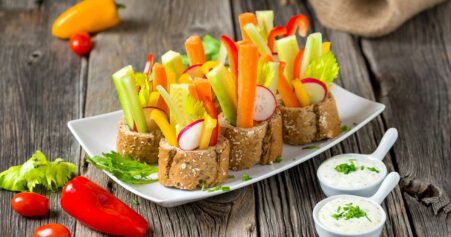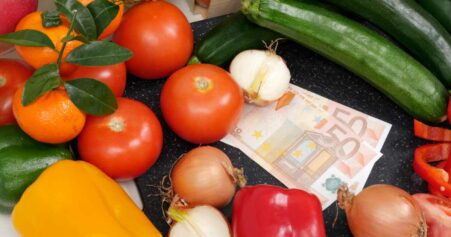Table of Contents
Have you ever heard of “Kinugoshi Tofu”? No? Well, you probably know tofu, and maybe you have even tried it. But not all tofu is the same. One particularly interesting variety is silken tofu, which is called “Kinugoshi tofu” in Japanese.
What is silken tofu, what makes it so special, and how can you enjoy its benefits?
Did you know …
… that tofu was first mentioned in writing in 965 B.C. (soyinfocenter, 2019)?
Silken Tofu Production
Industrial production
The first part of the manufacturing process is the same for both silken and firm tofu: it starts with the soybean from which the soy milk is extracted. Next is the step that makes the difference: for silken tofu, the liquid is not heated; nigari – a calcium salt extracted from sea salt – (according to traditional Japanese production) or calcium sulfate (usually used in industrial production) is added cold. Nigari and calcium sulfate are coagulants, but they cannot develop their effect in the cold liquid. Coagulation does not occur until the mixture is sealed in hard vats and heated (pasteurized). As the whey is not removed, the characteristic soft consistency develops (Biothemen, 2019).
Compared to firm tofu, the silky version is often harder to come by: While you will probably look in vain for silken tofu in most supermarkets, you can usually find it in the refrigerated section of the health food store or in the Asian market – and, of course, on the Internet.
By the way, tofu does not get its name (only) because of its silky soft consistency: According to traditional Japanese methods, the tofu is wrapped in silk fabric and shaped.
Make Your Own Silken Tofu
You can make your own silken tofu with just a few ingredients. You will need 1 quart of soy milk and about 3/4 teaspoon of nigari, which you can buy for example at an Asian grocery store. Instead, you can also use 2 tablespoons of lemon juice or vinegar.
Here’s how to do it:
- Stir the nigari into a few teaspoons of water until dissolved.
- Add the dissolved nigari to the soy milk and stir gently.
- As an alternative to steps 1 and 2, you can add the lemon juice or vinegar directly to the soy milk and stir gently as well.
- Pour the mixture into small heatproof containers.
- Place the containers (or one, depending on size) in a heatable container such as a deep saucepan or pot.
- Add a little water so that it touches the sides of the containers but does not go over the top.
- Cover the container with a cloth-lined lid that fits snugly.
- Bring the water to a boil, reduce the heat to medium, and let the water simmer for about 10 minutes. This will coagulate the tofu.
- Remove the tofu from the pot and let it cool.
- After a while, you can either serve it hot or store it in the refrigerator for a few days.
(from WikiHow)
Taste and Nutritional Value of Silken Tofu
Because the water and soybean content of silken tofu varies slightly from manufacturer to manufacturer, there are differences in nutritional values. In general, the water content is relatively high, and the soybean content is about 20 %. Table 1 shows the average nutritional values of silken tofu according to the German Nutrient Database (BLS).
Table 1: Average nutritional values of silken tofu (MRI, 2017)
| Energy | 53 kcal |
| Protein | 5.5 g |
| Carbohydrates | 3.6 g |
| Fiber | 0.4 g |
| Fat | 3.2 g |
| Potassium | 220 mg |
| Calcium | 94 mg |
| Magnesium | 30 mg |
| Iron | 1200 µg |
Compared to firm tofu, silken tofu has a lower calorie content due to its higher water content. As a result, silken tofu contains only about half the minerals in the same amount of product.
Silken tofu is a low-fat protein source, although the protein content is naturally lower than in solid tofu, as are the other nutrients. Due to the good amino acid composition of soybeans, the protein in silken tofu also has a high bioavailability.
As it is relatively tasteless, it is mainly used for its consistency. It is ideal for this purpose because it absorbs the flavor of marinades very well and is easy to process.
How To Use Silken Tofu
Silken tofu can reach its full potential when combined with flavorful ingredients. It is good for all occasions and tastes: Silken tofu can be used sweet, savory, hot, cold, liquid, solid, and everything in between. Here are a few suggestions:
Sweet use
- for example with starch in cheesecake
- as a base for chocolate/berry mousse with cocoa, frozen berries, melted chocolate, pureed and “whipped” with thickener if needed
- in sauces diluted with vegan milk/juice with addition of cocoa and/or fruit
- in smoothies/shakes with fruit, vegetables, oatmeal, dried fruit
- as a base for creams, fillings (cakes, tiramisu, crème brûlée)
- ice cream with frozen berries
Savory Use
- in a quiche with vegetables
- as a soup, pureed with vegetables, (sweet) potatoes or sliced and marinated as an ingredient
- as a base for dips pureed with herbs, legumes
- in sauces pureed with vegetables, legumes
- in vegan “scrambled eggs”
- in vegan sour cream (well seasoned, e.g. on tarte flambée)
- whole or in small pieces, marinated and carefully fried as a side dish
Our Conclusion
Silken tofu is unfairly overshadowed by firm tofu because it has a wide range of uses. It is a low-fat, high-protein alternative to cream, cottage cheese and the like.
A tip: Don’t tell your guests the secret ingredient until they have tasted it. This is sure to make their eyes pop.









Leave a Reply